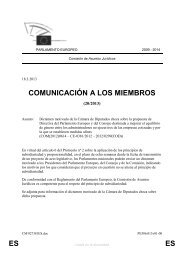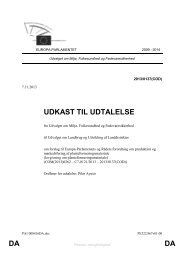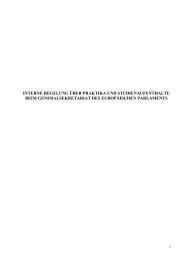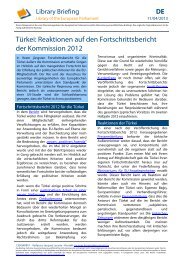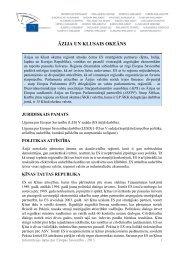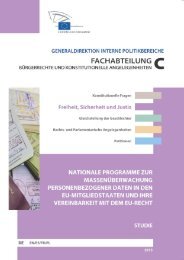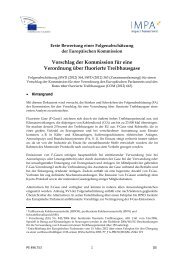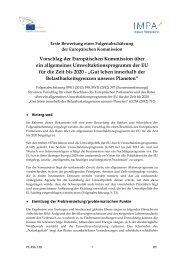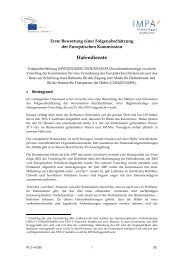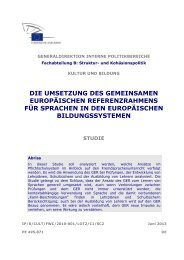Link to the study - European Parliament - Europa
Link to the study - European Parliament - Europa
Link to the study - European Parliament - Europa
Create successful ePaper yourself
Turn your PDF publications into a flip-book with our unique Google optimized e-Paper software.
Policy Department D: Budgetary Affairs<br />
____________________________________________________________________________________________<br />
None of <strong>the</strong> affected countries was prepared for that closure, even though this early preparedness<br />
was a common safety principle well addressed in international Safety Guides:<br />
Financial arrangements for <strong>the</strong> decommissioning of those reac<strong>to</strong>rs were not available, <strong>the</strong>reby<br />
not implementing applicable international safety standards, e.g. <strong>the</strong> Safety Guide (IAEA 1999)<br />
that went in<strong>to</strong> effect five years before <strong>the</strong> first plant shut down. It requires explicitly <strong>the</strong><br />
establishment of dedicated funds for decommissioning 12 , and requires that those are<br />
immediately (!) set up for already existing and operating reac<strong>to</strong>rs 13 .<br />
No conceptual planning for <strong>the</strong>ir later decommissioning had previously been established, even<br />
though international safety standards explicitly required that (IAEA 1999) 14 , and called for this<br />
planning, including for existing reac<strong>to</strong>rs 15 'without undue delay'.<br />
The reac<strong>to</strong>rs were of <strong>the</strong> older Soviet PWR and RBMK types and not designed having <strong>the</strong>ir later<br />
decommissioning as a layout criteria in mind, which should be a basic design criteria nowadays<br />
(IAEA 1999).<br />
The requirement <strong>to</strong> have enough resources at hand <strong>to</strong> decommission a facility, whenever this is<br />
needed, can also be derived from <strong>the</strong> Fundamental Safety Principle 7 ('Protection of present and<br />
future generations'):<br />
'Where effects could span generations, subsequent generations have <strong>to</strong> be adequately protected<br />
without any need for <strong>the</strong>m <strong>to</strong> take significant protective actions.' (IAEA 2006)<br />
As a consequence of this failure <strong>to</strong> implement <strong>the</strong>se international principles and recommendations,<br />
<strong>the</strong> opera<strong>to</strong>rs and <strong>the</strong> three member states were majorly unprepared for <strong>the</strong> shutdown of <strong>the</strong>se<br />
installations 16 . Nei<strong>the</strong>r were financial means nor were <strong>the</strong> necessary procedural steps, organisational<br />
12<br />
The Decommissioning Safety Guide (IAEA 1999) requires <strong>the</strong> following: '5.24. In order <strong>to</strong> provide <strong>the</strong><br />
necessary confidence that <strong>the</strong> resources will be available <strong>to</strong> maintain radiation and environmental protection<br />
during decommissioning, provision for allocating resources should be established early in <strong>the</strong> planning of <strong>the</strong><br />
nuclear power plant design. According <strong>to</strong> <strong>the</strong> legal framework, such a mechanism should be established before<br />
operation in order <strong>to</strong> secure <strong>the</strong> funds needed for decommissioning. The mechanism should be sufficiently<br />
robust <strong>to</strong> provide for decommissioning needs in <strong>the</strong> event of premature shutdown of <strong>the</strong> reac<strong>to</strong>r installation.<br />
Irrespective of <strong>the</strong> type of financial mechanisms used, provision for premature decommissioning should be in<br />
place, should it be needed.'<br />
13<br />
Decommissioning Safety Guide (IAEA 1999): '5.25. For existing reac<strong>to</strong>r installations with no financial<br />
assurance mechanism for decommissioning, such a mechanism should be established without undue delay.'<br />
14<br />
Decommissioning Safety Guide (IAEA 1999): '5.6. An initial plan for decommissioning should be prepared and<br />
submitted by <strong>the</strong> operating organization in support of <strong>the</strong> license application for <strong>the</strong> construction of a new<br />
reac<strong>to</strong>r. Although <strong>the</strong> level of detail in <strong>the</strong> initial plan will necessarily be lower than that in <strong>the</strong> final<br />
decommissioning plan, many of <strong>the</strong> aspects listed in para. 5.11 should be considered in a conceptual fashion. A<br />
generic <strong>study</strong> showing <strong>the</strong> feasibility of decommissioning may suffice for this plan, particularly in standardized<br />
installations. Depending on applicable regulations, <strong>the</strong> plan should address <strong>the</strong> costs and <strong>the</strong> means of<br />
financing <strong>the</strong> decommissioning work.'<br />
15<br />
Decommissioning Safety Guide (IAEA 1999): '5.7. In cases where an operational plant does not have an initial<br />
plan for decommissioning, a decommissioning plan reflecting <strong>the</strong> operational status of <strong>the</strong> installation should<br />
be prepared without undue delay.'<br />
16<br />
Only Slovakia had, at that time, encountered a reac<strong>to</strong>r under shutdown, Bohunice A1, see ANNEX 1 of this<br />
<strong>study</strong>, and had limited experiences with its decommissioning.<br />
96




